CMDC has worked in collaboration with Khaled Galal from Concordia University
Supporting Innovation through Research Partnerships
Work has been conducted on the following projects:
Shear Walls with Boundary Elements
Project Summary:
Reinforced masonry shear walls are effective structural elements to resist lateral loads on buildings including wind loads and seismic loads. This research project led by Dr. Galal focuses on testing of reinforced masonry shear wall configurations to develop more economical methods of construction for buildings that are required to resist moderate earthquake loads. Focusing on the detailing of reinforcement, strategies to enhance the performance of current masonry construction methods are being developed.
This project includes testing masonry materials, of half-scale reinforced masonry shear walls (including rectangular walls, walls with boundary elements, and even partially-grouted walls), and computer modeling and analysis of the walls and of whole buildings with masonry shear walls.
In addition to developing new strategies for design and improving the seismic safety of buildings, the project also contributes to better understanding the characteristics of masonry materials in general.
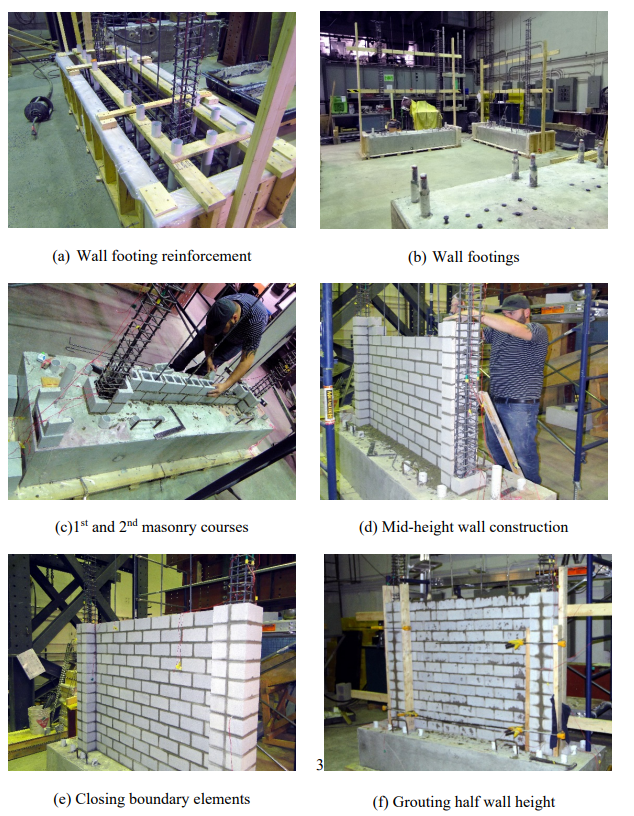
Recent CMS Articles:
https://www.canadamasonrydesigncentre.com/wp-content/uploads/14th_symposium/101-Zorainy.pdf
https://www.canadamasonrydesigncentre.com/wp-content/uploads/14th_symposium/065-Aly.pdf
https://www.canadamasonrydesigncentre.com/wp-content/uploads/14th_symposium/003-AbdelRahman.pdf
https://www.canadamasonrydesigncentre.com/wp-content/uploads/14th_symposium/002-Hamzeh.pdf
https://www.canadamasonrydesigncentre.com/wp-content/uploads/13th_symposium/138-Hamzeh-Paper-1.pdf
https://www.canadamasonrydesigncentre.com/wp-content/uploads/13th_symposium/048-Aly-Paper-1.pdf
Select Journal Articles:
AbdelRahman, Belal, and Khaled Galal. “Experimental investigation of axial compressive behavior of square and rectangular confined concrete-masonry structural wall boundary elements.” Engineering Structures 243 (2021): 112584.
Albutainy, Mohammed, and Khaled Galal. “Experimental investigation of reinforced concrete masonry shear walls with C-shaped masonry units boundary elements.” In Structures, vol. 34, pp. 3667-3683. Elsevier, 2021.
Hosseinzadeh, Shadman, and Khaled Galal. “Probabilistic seismic resilience quantification of a reinforced masonry shear wall system with boundary elements under bi-directional horizontal excitations.” Engineering Structures 247 (2021): 113023.
Aly, Nader, and Khaled Galal. “In-plane cyclic response of high-rise reinforced concrete masonry structural walls with boundary elements.” Engineering Structures 219 (2020): 110771.
Aly, Nader, and Khaled Galal. “Experimental investigation of axial load and detailing effects on the inelastic response of reinforced-concrete masonry structural walls with boundary elements.” Journal of Structural Engineering 146, no. 12 (2020): 04020259.
Hosseinzadeh, Shadman, and Khaled Galal. “System-level seismic resilience assessment of reinforced masonry shear wall buildings with masonry boundary elements.” In Structures, vol. 26, pp. 686-702. Elsevier, 2020.
Aly, Nader, and Khaled Galal. “Seismic performance and height limits of ductile reinforced masonry shear wall buildings with boundary elements.” Engineering Structures 190 (2019): 171-188.
Hamzeh, Layane, Ahmed Ashour, and Khaled Galal. “Development of fragility curves for reinforced-masonry structural walls with boundary elements.” Journal of Performance of Constructed Facilities 32, no. 4 (2018): 04018034.
Obaidat, Ala’T., Ahmed Ashour, and Khaled Galal. “Stress-strain behavior of C-shaped confined concrete masonry boundary elements of reinforced masonry shear walls.” Journal of Structural Engineering 144, no. 8 (2018): 04018119.
El Ezz, Ahmad Abo, and Khaled Galal. “Compression behavior of confined concrete masonry boundary elements.” Engineering Structures 132 (2017): 562-575.
Select Theses and HQP:
Belal AbdelRahman: https://spectrum.library.concordia.ca/id/eprint/988221/
Nader Aly: https://spectrum.library.concordia.ca/id/eprint/986248/
Layane Hamzeh: https://spectrum.library.concordia.ca/id/eprint/988186/
Ala’ Obaidat: https://spectrum.library.concordia.ca/id/eprint/982885/
Reinforced Masonry Shear Walls
Project Summary:
Reinforced masonry shear walls are effective structural elements to resist lateral loads on buildings including wind loads and seismic loads. This research project led by Dr. Galal focuses on testing of reinforced masonry shear wall configurations to develop more economical methods of construction for buildings that are required to resist moderate earthquake loads. Focusing on the detailing of reinforcement, strategies to enhance the performance of current masonry construction methods are being developed. This project includes testing masonry materials, of half-scale reinforced masonry shear walls (including rectangular walls, walls with boundary elements, and even partially-grouted walls), and computer modeling and analysis of the walls and of whole buildings with masonry shear walls. In addition to developing new strategies for design and improving the seismic safety of buildings, the project also contributes to better understanding the characteristics of masonry materials in general.
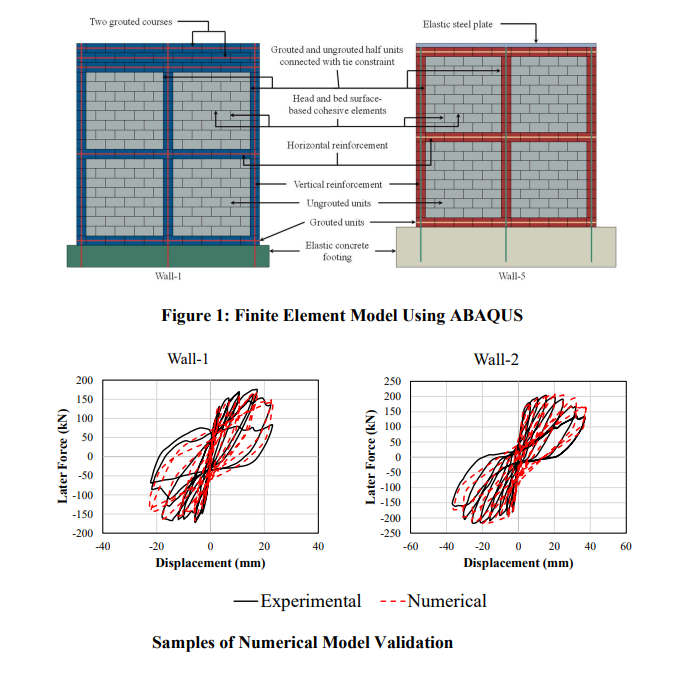
Recent CMS Articles:
Select Journal Articles:
Elmeligy, Omar, Nader Aly, and Khaled Galal. “Sensitivity analysis of the numerical simulations of partially grouted reinforced masonry shear walls.” Engineering Structures 245 (2021): 112876.
Aly, Nader, and Khaled Galal. “Effect of ductile shear wall ratio and cross-section configuration on seismic behavior of reinforced concrete masonry shear wall buildings.” Journal of Structural Engineering 146, no. 4 (2020): 04020020.
ElDin, Hany M. Seif, Ahmed Ashour, and Khaled Galal. “Seismic performance parameters of fully grouted reinforced masonry squat shear walls.” Engineering Structures 187 (2019): 518-527.
ElDin, Hany M. Seif, Nader Aly, and Khaled Galal. “In-plane shear strength equation for fully grouted reinforced masonry shear walls.” Engineering Structures 190 (2019): 319-332.
Recent NAMC Articles:
Aly N. and Galal K. (2019, June). “Influence of Ductile Shear Wall Ratio on the Seismic Performance of Reinforced Concrete Masonry Shear Wall Buildings.” In P.B. Dillon & F.S. Fonseca (Eds.), Proceedings of the Thirteenth North American Masonry Conference. Paper presented at the 13th North American Masonry Conference, Salt Lake City, Utah (pp. 1462–1474). Longmont, CO: The Masonry Society.
Select Theses and HQP:
Shadman Hosseinzadeh: https://spectrum.library.concordia.ca/id/eprint/987818/
Hany ElDin: https://spectrum.library.concordia.ca/id/eprint/980968/
Masonry Prisms
Project Summary:
Masonry prisms are essential structural elements utilized in construction to evaluate the compressive strength and other mechanical properties of masonry materials. These test specimens, constructed by bonding masonry units with mortar, replicate real-world construction conditions, ensuring the relevance of the obtained data. CSA S304 provides guidelines for the preparation, testing, and analysis of these prisms. The testing process involves subjecting the prisms to axial loads to determine compressive strength and may include shear strength tests to assess resistance to lateral forces.
In this research, masonry prisms are used to investigate the impact of fibre reinforced grout, and boundary elements built using C-shaped blocks. The resulting data contributes to the development of construction guidelines and safety standards, informing the design of durable and secure masonry structures in real-world applications. In essence, masonry prisms play a crucial role in advancing our understanding of masonry behavior and promoting the reliability of construction practices.
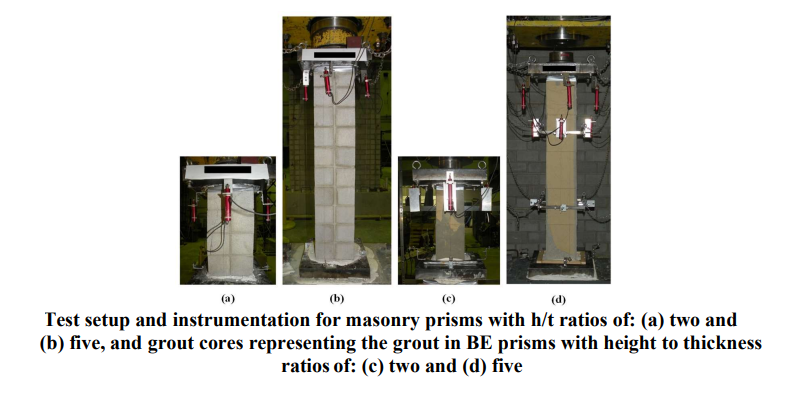
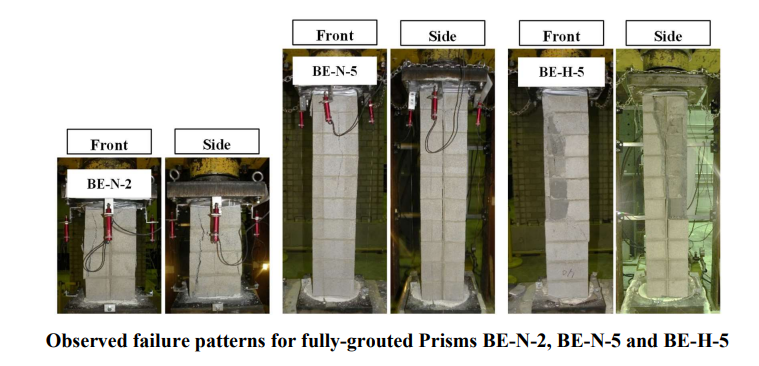
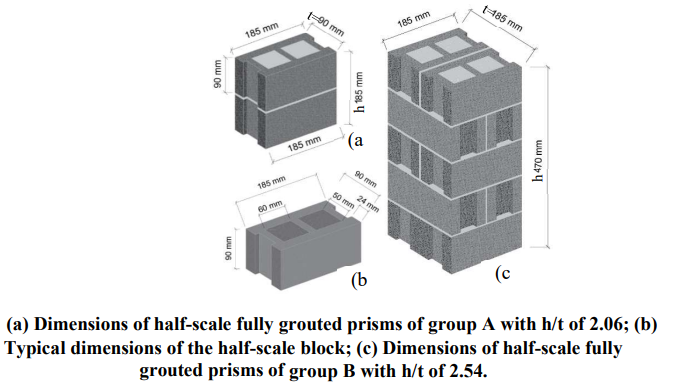
Recent Journal Articles:
Gouda, Omar, Ahmed Hassanein, Tarik Youssef, and Khaled Galal. “Stress-strain behaviour of masonry prisms constructed with glass fibre-reinforced grout.” Construction and Building Materials 267 (2021): 120984.
AbdelRahman, Belal, and Khaled Galal. “Influence of pre-wetting, non-shrink grout, and scaling on the compressive strength of grouted concrete masonry prisms.” Construction and Building Materials 241 (2020): 117985.
Masonry Columns Strengthened by FRP
Project Summary:
Research on masonry columns strengthened by Fiber-Reinforced Polymer (FRP) composites aims to enhance the load-carrying capacity and ductility of existing structures. This involves applying high-strength fibers embedded in a polymer matrix externally to masonry columns, particularly beneficial for retrofitting older structures or improving original design capacities. The test matrix was designed to measure the effect of the presence of longitudinal steel reinforcement in the columns on the compressive strength of FRP-confined concrete masonry.
As the demand for sustainable retrofitting solutions increases, research in this area plays a pivotal role in advancing innovative techniques for strengthening masonry columns, ensuring resilience in diverse environmental and loading conditions.
Recent NAMC Articles:
Alotaibi K. and Galal K. (2019, June). “Compressive Strength of FRP-Confined Concrete Masonry With and Without Longitudinal Steel Reinforcement.” In P.B. Dillon & F.S. Fonseca (Eds.), Proceedings of the Thirteenth North American Masonry Conference. Paper presented at the 13th North American Masonry Conference, Salt Lake City, Utah (pp. 1523–1529). Longmont, CO: The Masonry Society
Select Journal Articles:
El-Sokkary, Hossam, and Khaled Galal. “Performance of eccentrically loaded reinforced-concrete masonry columns strengthened using FRP wraps.” Journal of Composites for Construction 23, no. 5 (2019): 04019032.
Alotaibi, Khalid Saqer, and Khaled Galal. “Experimental study of CFRP-confined reinforced concrete masonry columns tested under concentric and eccentric loading.” Composites Part B: Engineering 155 (2018): 257-271.
Alotaibi, Khalid Saqer, and Khaled Galal. “Axial compressive behavior of grouted concrete block masonry columns confined by CFRP jackets.” Composites Part B: Engineering 114 (2017): 467-479
Select Theses and HQP: :
Khalid Alotaibi: https://spectrum.library.concordia.ca/id/eprint/984232/



